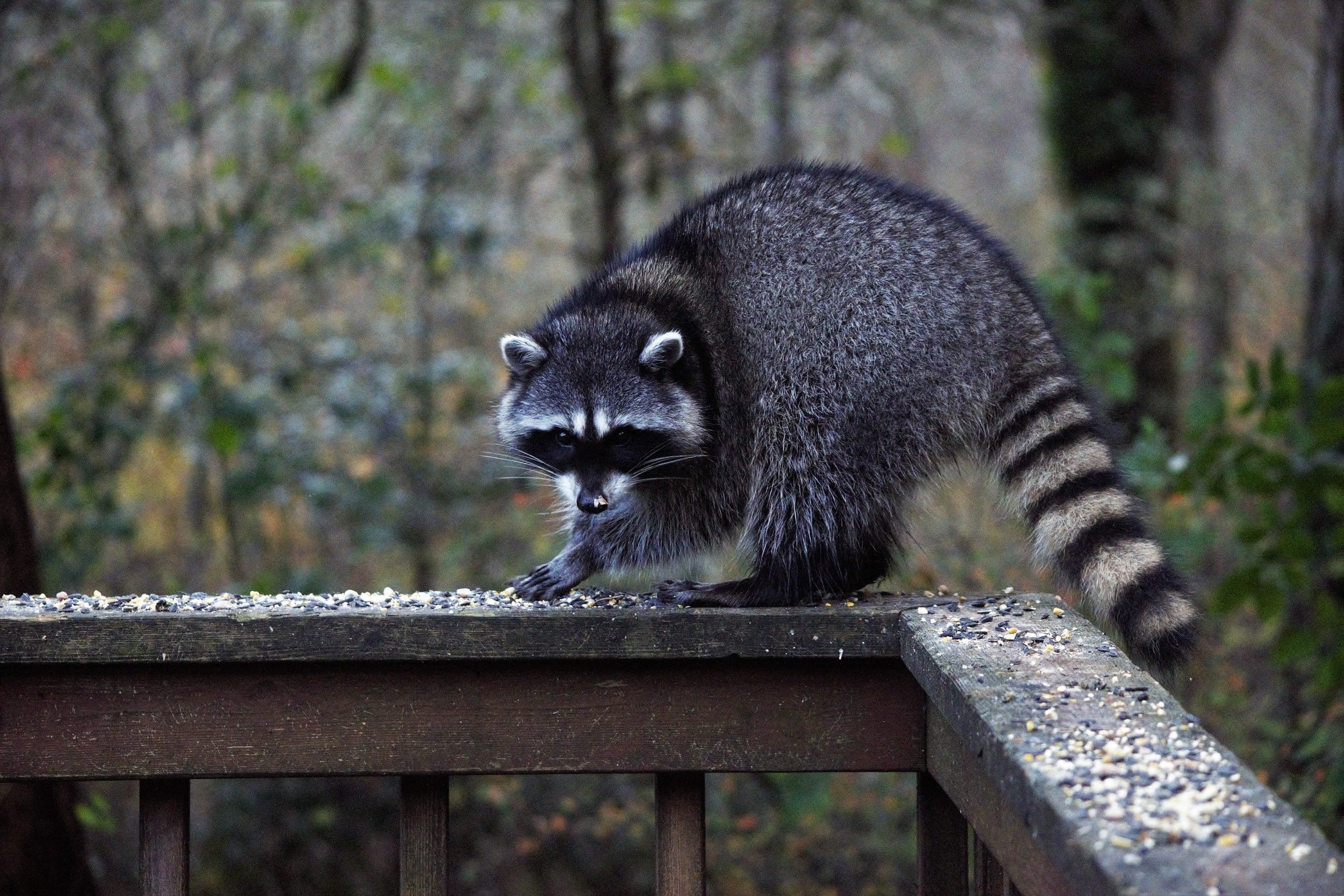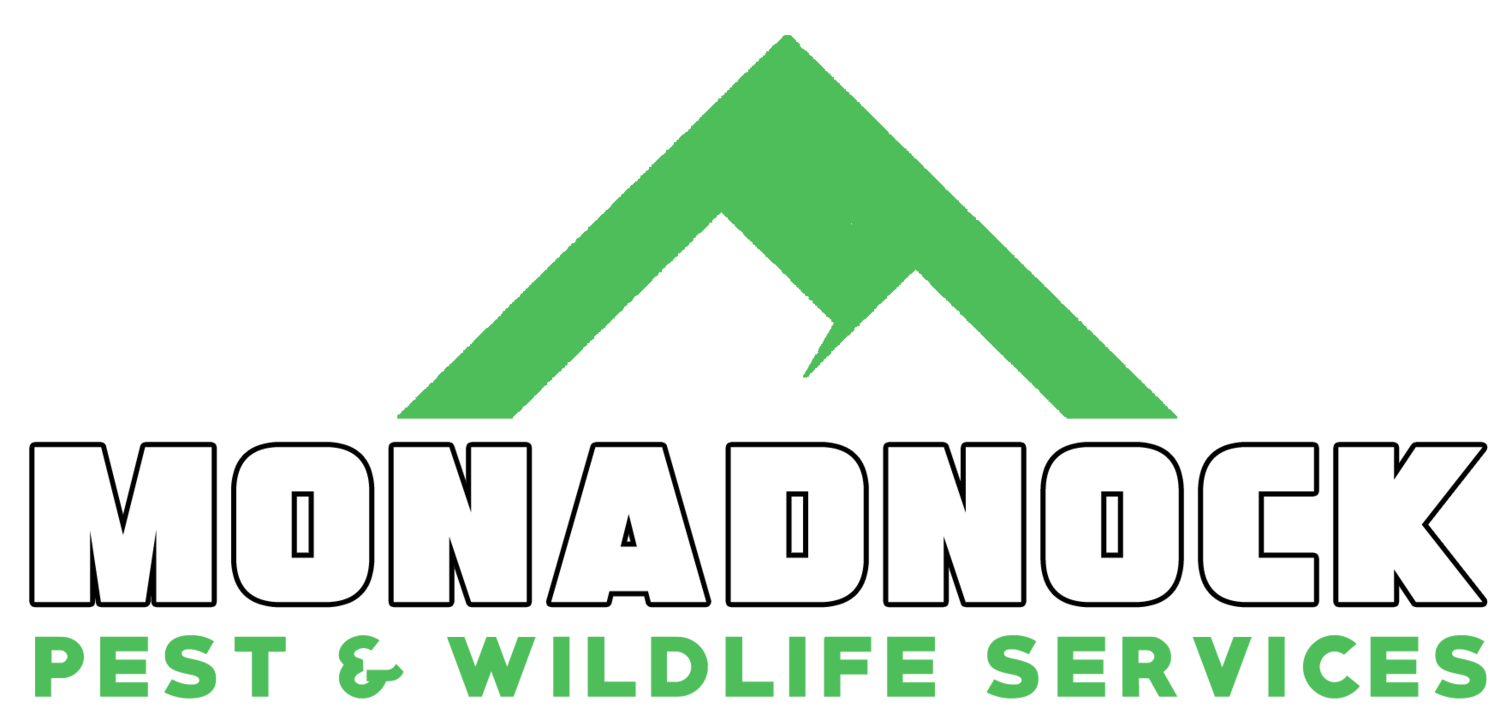
Raccoon Removal
Masked Bandits.
The Raccoon (Procyon lotor) is a common wild animal in both urban and rural settings across New Hampshire. Raccoons are both plentiful and highly adaptable to living around humans and foraging on both natural resources as well as waste resources created by humans - such as trash, bird seed, discarded processed foods, livestock, and gardens. Raccoons are found in every habitat that The Granite State has to offer; from deciduous and mixed forests, to mountainous areas, to coastal marshes, and even urbanized city-spaces or residential backyards. Raccoons tend to become a nuisance animal when they prey on livestock such as chickens, or invade human structures and chimneys to find confined areas to birth and raise young. Despite their adorable appearance, raccoons tend to be rather ornery and very defensive when they feel threatened.
Monadnock Pest & Wildlife deploys several control tactics for managing raccoon conflict - including exclusion/eviction services to remove raccoons from a building or structure, as well as trapping and translocation services to completely remove the individual(s) from the property. With well over a decade of raccoon handling and trapping experience, we’re the premier raccoon management authority in New Hampshire.
Appearance:
Raccoons are the largest of the procyonid family, having a body length of 6 to 28 inches and a body weight of 11 to 57 pounds. Its fur coat, which can range from light gray to brown, consists of dense cottony underfur, which insulates the animal against cold weather. A raccoon's most distinctive features include their extremely dexterous front paws, as well as their textbook facial mask-like markings - thought to assist with reducing glare and enhancing night vision, and their bushy ringed tail.
Habitat & Diet:
Comically known for their nickname in popular culture - the “trash panda” - raccoons have an incredibly diverse diet based on their individual habitats. Since a raccoon’s diet consists of such a variety of different foods, raccoons are considered to be one of the world's most omnivorous animals. While its diet in spring and early summer consists mostly of insects, worms, and other animals, raccoons prefer fruits and nuts, such as acorns and walnuts, which emerge in late summer and autumn, and represent a rich calorie source for building up fat needed for winter. Raccoons are also commonly found foraging along waterways for fish, frogs, and crayfish - which they have been known to clean and “wash” at the water’s edge with their dexterous front paws before consumption - a term known as “dousing”.
Raccoons are known predators of eggs and hatchlings in both bird and reptile nests; to such a degree that, for threatened species, raccoon removal programs are both instituted and commonly carried out to reduce depredation on vulnerable populations. In addition to the food sources listed above, raccoons will also commonly forage around dumpsters, trash waste, and bird-feeders in urban settings.
Breeding & Behavior:
Raccoons usually mate in late January through mid-March. Litters of 2-5 kits (also known as cubs) are born in April-May. During the early spring, human dwellings become increasingly vulnerable as pregnant females manipulate structure gaps to access “safe” spaces in attics, crawlspaces, voids and chimney chases. These “den” locations are usually hollow trees in wooded areas.
Life expectancy for wild raccoons is usually 1.5-3 years. The most frequent natural cause of death in the North American raccoon population is disease - such as distemper and rabies, which can reach epidemic proportions and eliminate large portions of localized raccoon populations. In areas with heavy vehicular traffic, these factors can account for up to 90% of all deaths of adult raccoons. The most common “natural” predators of the raccoon are bobcats, coyotes, and great horned owls. Home range sizes of urban raccoons are 7.5 to 100 acres for females and 20 to 200 acres for males. In small towns and suburbs, many raccoons sleep in nearby forested green-spaces after foraging in human-dense areas. Raccoons will find harborage in densely settled areas in garage, abandoned homes, sheds, drainage culverts and other man-made structures.
Although previously thought to be solitary, modern evidence suggests that raccoons engage in sex-specific social groups. Related females often share a common area, while unrelated males live together in groups of up to four raccoons. Raccoons can commonly be found foraging together in both rural and urban settings. As placental mammals, Raccoons can and do carry rabies. Disease spread is caused by the neurotropic rabies virus carried in the saliva and transmitted by bites. Of the 6,940 documented rabies cases reported in the United States in 2006, 2,615 (37.7%) were found in raccoons. Oral vaccination programs to fight the spread of the disease have been implemented by government entities. The main symptoms of rabies in raccoons are a generally sickly appearance, impaired mobility, abnormal vocalization, and aggressiveness. There may, however, be no visible signs at all. Distemper virus is also common among raccoon populations. An epizootic virus, distemper is the most frequent natural cause of death in the North American raccoon population and affects individuals of all age groups. For example, 94 of 145 raccoons died during an outbreak in Clifton, Ohio, in 1968. It may occur along with a following inflammation of the brain (encephalitis), causing the animal to display rabies-like symptoms.
Nuisance characteristics:
The increasing number of raccoons in urban areas has resulted in diverse reactions in humans, ranging from outrage at their presence to deliberate feeding.
Raccoons may cause conflict with humans in both rural and suburban settings. Raccoon conflict tends to include:
Harborage and damage to sheds, crawlspaces, chimneys and other structures.
Damage to agricultural produce, fruit trees and home gardens.
Depredation on livestock such as chickens.
Public safety due to their notorious susceptibility to the Rabies Virus, and accumulation of waste inside homes & businesses.
Having trouble with Raccoons? If you live in southern New Hampshire, we’re ready to assist - contact Monadnock Pest & Wildlife today for a worry-free inspection and estimate to assist with moving your resident Raccoons along!
Give us a call:
(603)-784-5828
Not much of a phone talker?
Send us a message and we’ll respond to your inquiry shortly.
We check our email messages promptly!


